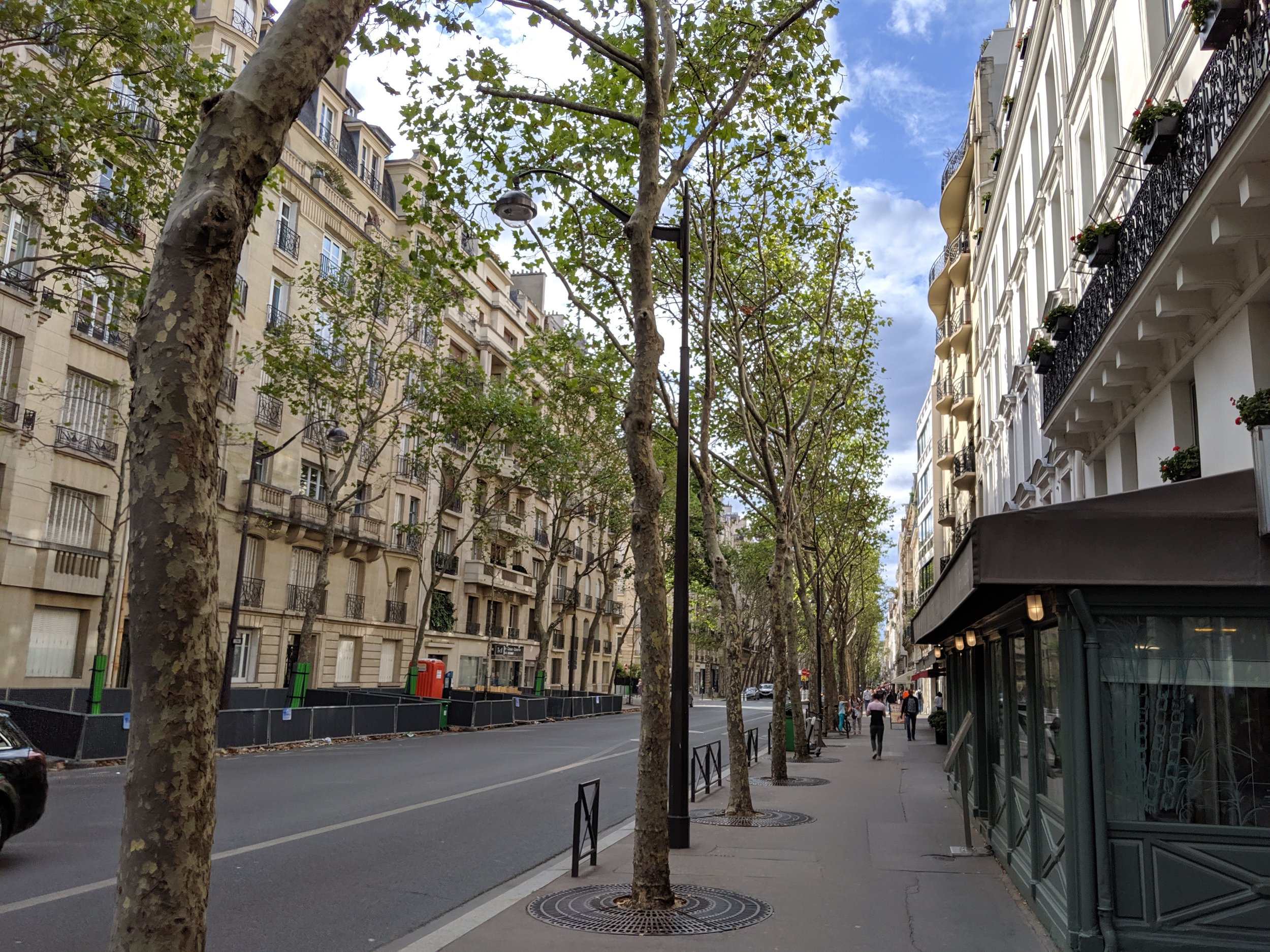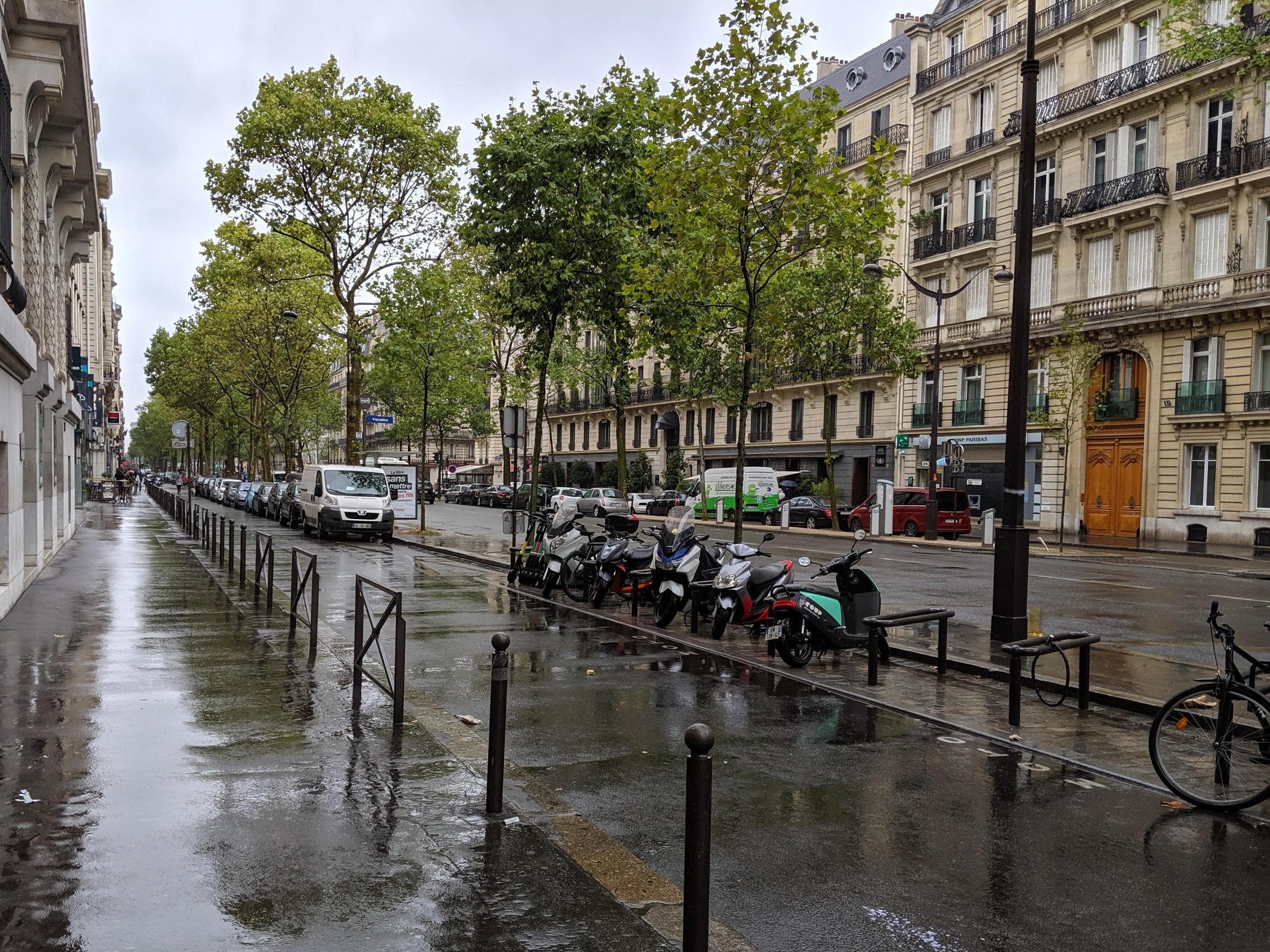The Streets of Paris
I’m very fortunate to have married someone who loves to travel and to have two daughters who (for the most part) enjoy it as well. Since they were born (2004 and 2007), we’ve been planning to take them to Europe when they were teenagers. A huge pile of frequent flier miles helped us bring those plans to reality last week.
Since I’m a little jet-lagged and knowing I’m headed back on the road tomorrow, I thought today I would share some photos I took of the streets of Paris with some quick observations. And, please, I know the cultures of the United States and France are very different and I’m not suggesting it would be easy or straightforward for North American cities to become Paris, but as my friend John Anderson has said many times, we don’t need to be Paris, we just need to be a slightly less crappy version of America.
In that mindset, there are certainly a lot of simple things that can be learned.
1. Street Trees
Especially here in my hometown, I’m constantly hearing how we can’t have street trees, largely for maintenance reasons. The leaves drop and mess up the drainage. The roots damage the pipes. They are in the way for people in wheelchairs. Car drivers will hit them. And my favorite: If we ever need to widen the street, they are in the way.
And, of course, there is the persistent criticism of street trees: They won’t grow. My response to all of these criticisms has been to point to amazing places full of street trees and say, “If they can do it, why can’t we?” Paris is full of street trees, and it has been doing it successfully for a lot longer than any modern North American city has existed.
2. Ubiquitous Bollards
In the United States, our civil engineers often insist on a clear zone on each side of the street. You can ‘t place anything in the clear zone because, by the theory of Forgiving Design, if an automobile is driven off the driving surface, the sudden stop from hitting a fixed object will harm the driver and any passengers of the vehicle. This thinking is rightfully applied to highways and areas where we want traffic to move fast without the potential for conflict. When we apply Forgiving Design to local streets, though, we get absurdities like breakaway light poles along sidewalks. There isn’t a clearer statement of the North American engineer’s values than that.
I actually encountered an engineer once that didn’t allow a sandwich board sign because of the hazard it presented to automobiles should they strike it.
Needless to say, Paris has gone far in the opposite direction. Seemingly everywhere a vehicle could operate at speeds that would injure people, they have erected obstacles to keep the errant car from striking a human. Absorbing the kinetic energy of a collision is the responsibility of the car and driver, not the people walking along the street. This is cheap, easy, and really effective.
3. Narrow Streets
In the United States, we use transportation funding as a mechanism to address public safety concerns. Our fire departments often operate on the theory that if you can respond to an emergency quickly, the public is safer. European countries have a much different approach, one that emphasizes prevention over response time. Here in the United States, we require wide lanes, wide shoulders and wide clear zones along our streets so that emergency response vehicles travel unhindered to any emergency. The concept of a clear zone is ridiculous in Paris.
I’ll note that you are far less likely to die in a fire in a European city than an American one. Ditto a traffic collision. Two of our classic Strong Towns memes apply here.
4. Slip Lanes
When a design prioritizes building wealth in a place instead of moving traffic, the basic geometry of the public space shifts. In terms of wealth creation, I really like how this street is designed. There is human space on the edge; wide enough for two people to walk side-by-side and meet a pair doing likewise coming from the opposite direction. They are protected by bollards along the entire stretch. Then there is a one-way slip lane for drivers seeking a place to park a vehicle — these lanes are constrained to ensure slow speeds. Then there is a parking lane, although with a decent amount of that space given over to scooters and bikes. Then a boulevard to provide some vertical framing for the street in the form of street trees and nice lighting. The center has two driving lanes with opposing flow, and then it all repeats along the other side.
For cities that want to make their stroads into wealth-creating streets, this is a great cross section to utilize.
5. Shared Space Intersections
Finally, I’m a huge fan of shared space intersections—intersections that lack traffic markings, including stop signs or traffic signals—and I ran into a great one in Versailles. With tired kids and wife, I didn’t get to linger as long as I would have liked to, but in the short time I was there, I did see the humane mingling of humans and vehicles induced by slow speeds and the more chaotic design.
The idea of a chaotic design is anathema to everything North American engineering practice stands for, yet when drivers are less sure of their own path—let alone the path of others—they do remarkable things like slow down, look people in the eye, and yield. It’s a beautiful thing to watch; it’s just too bad there are so few examples here in the United States.
I’ll also note, for those who criticize shared space on accessibility grounds, that I did not encounter anyone in a wheelchair or with a vision impairment in my short time there. I would have liked to stick around and observe that. The pavement markings and materials seemed to me intuitive to someone with a disability, but I can’t say that from experience, so I would have liked to have seen someone else experience it. It would be very hard for a vision-impaired person (or any person) to not be visible to the slow-moving traffic in this space.








Charles Marohn (known as “Chuck” to friends and colleagues) is the founder and president of Strong Towns and the bestselling author of “Escaping the Housing Trap: The Strong Towns Response to the Housing Crisis.” With decades of experience as a land use planner and civil engineer, Marohn is on a mission to help cities and towns become stronger and more prosperous. He spreads the Strong Towns message through in-person presentations, the Strong Towns Podcast, and his books and articles. In recognition of his efforts and impact, Planetizen named him one of the 15 Most Influential Urbanists of all time in 2017 and 2023.